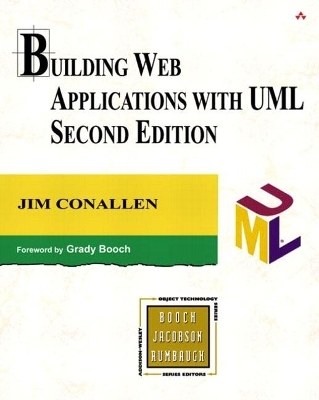
Building Web Applications with UML
Addison Wesley (Verlag)
978-0-201-73038-8 (ISBN)
- Keine Verlagsinformationen verfügbar
- Artikel merken
The Unified Modeling Language (UML) is the standard modeling language for software systems. Using UML to model web application design allows designers to easily integrate web applications with other systems modeled in UML. Building Web Applications with UML, Second Edition presents an extension to UML suitable for web application design. Based on the author's own experience developing UML web applications, and incorporating helpful reader feedback from the first edition, the book identifies and addresses modeling problems unique to page based web applications, and offers a clear and straightforward solution. The reader is left with a clear understanding how to deal with the unique problems of modeling the design of page-based web applications, and how to take the model directly into working code.
Jim Conallen is the Web Modeling Evangelist at Rational Software Corporation, where he has continued his work on the development of the Web Application Extension for the Unified Modeling Language. Prior to joining Rational, he was a consultant specializing in full life cycle object-oriented development. He has built client/server and web-based systems in the transportation, telecommunications, and health care domains; has architected large, high-volume transaction processing systems; and has designed and developed applications in C++, Smalltalk, Java, Delphi and Visual Basic. Jim is a frequent speaker on topics ranging from web application modeling to software best practices. He has written for many industry publications, including ASPToday.com, Rose Architect, and Communications of the ACM. 0201730383AB06262002
Foreword.
Preface.
I. OVERVIEW OF MODELING AND WEB-RELATED TECHNOLOGIES.
1. Introduction.
What This Book Is About.
Role of Modeling.
Role of Process.
Influences of Architecture.
2. Web Application Basics.
HTTP.
Document Identification.
Domain Names.
Resource Identifiers.
Fault Tolerance.
HTML.
Anchors.
Forms.
Frames.
Web Applications.
Client State Management.
Enabling Technologies.
3. Dynamic Clients.
Document Object Model.
Scripting.
JavaScript Objects.
Custom JavaScript Objects.
Events.
Java Applets.
ActiveX/COM.
4. Beyond HTTP and HTML.
Distributed Objects.
RMI / IIOP.
DCOM.
XML.
Web Services.
SOAP.
UDDI.
WSDL.
5. Security.
Types of Security Risks.
Technical Risk.
Server-Side Risks.
Client-Side Risks.
Cookies.
JavaScript.
Java.
ActiveX.
Plug-ins and MIME Types.
Security Strategies.
Encryption.
Best Practices.
Modeling Secure Systems.
II. BUILDING WEB APPLICATIONS.
6. Process.
Overview of Software Development.
Software Development for Web Applications.
Develop Software.
Iterate.
Software Iteration.
The Artifacts.
Project Management Set.
Domain Set.
Requirements Set.
Analysis Set.
Design Set.
Implementation Set.
Test Set.
Deployment Set.
7. Defining the Architecture.
Architectural Viewpoints.
Requirements Viewpoint.
Design Viewpoint.
Realization Viewpoint.
Test Viewpoint.
Viewpoint Mappings.
Architecture Activities.
Examining and Prioritizing Use Cases.
Developing Candidate Architectures.
Prototyping: Knowing when to stop.
Web Application Presentation Tier: Architectural Patterns.
Thin Web Client.
Thick Web Client.
Web Delivery.
8. Requirements and Use Cases.
The Vision.
Requirements.
Glossary.
Gathering and Prioritizing Requirements.
Use Cases.
The Use Case Model.
Avoiding Functional Decomposition.
Use Case Model Structure.
The User Experience.
9. The User Experience.
Artifacts of the UX Model.
Screens.
Storyboards.
Navigational Paths.
UX Modeling with UML.
Screen Flow.
User Input.
Screen Compartments.
Storyboard Realizations.
Navigational Map.
UX Model Stereotype Summary.
10. Analysis.
Iteration.
Analysis Model Structure.
Defining the Top Level Model.
Analysis Elements.
Structural Elements.
Behavioral Elements.
UX Model Mapping.
Architecture Elaboration.
11. Design.
Introduction to the Web Application Extension for UML.
Logical View.
Component View.
Designing Web Applications.
Thick Web Client Applications.
Web Delivery Web Applications.
Identifying Web Pages.
Client Side Scripting.
Mapping to the UX Model.
Integrating with Content Management Systems.
Guidelines for Web Application Design.
12. Advanced Design.
HTML Frames.
Advanced Client-Side Scripting.
Script Libraries.
Script Objects.
Virtual and Physical HTTP Resource.
JavaServer Page Custom Tags.
13. Implementation.
Number Store Main Control Mechanism.
Glossary Application Tag Libraries.
Appendix A: Web Application Extension Profile, Version 2.
Overview.
HTML to UML.
URL Resolution.
Elements.
UML to HTML.
Component Packages.
Components.
Classes.
Association Class: «URL Parameters».
Associations.
Mapping Web Elements to UML, and Vice Versa
JavaServer Page to UML.
UML to JavaServer Page.
Appendi
| Erscheint lt. Verlag | 11.10.2002 |
|---|---|
| Reihe/Serie | Addison-Wesley Object Technology Series |
| Mitarbeit |
Herausgeber (Serie): Jacqui Doucette |
| Verlagsort | Harlow |
| Sprache | englisch |
| Themenwelt | Informatik ► Office Programme ► Outlook |
| Informatik ► Software Entwicklung ► UML | |
| Mathematik / Informatik ► Informatik ► Web / Internet | |
| Informatik ► Weitere Themen ► Hardware | |
| ISBN-10 | 0-201-73038-3 / 0201730383 |
| ISBN-13 | 978-0-201-73038-8 / 9780201730388 |
| Zustand | Neuware |
| Haben Sie eine Frage zum Produkt? |
aus dem Bereich


